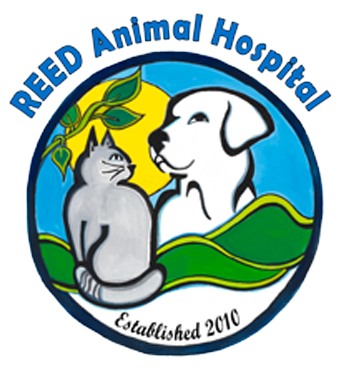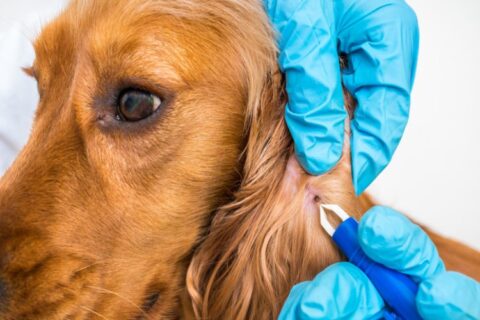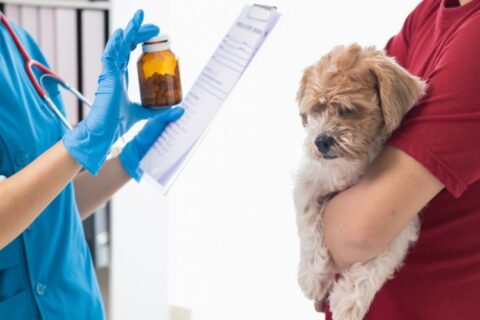Five Types of Dog Eye Discharge and What They Mean
Welcome to Reed Animal Hospital’s Informative Guide on Dog Eye Discharge

It’s common for dogs to have a little bit of goop in their eyes, and this is not necessarily a problem of any significance. You might see your dog’s eye watering because he’s got a bit of fur in it, or for some other harmless reason, like allergies. But when should you worry about dog eye discharge? Let’s take a deeper look into dog’s eye health, and when you need to be concerned about problems like eye infections.
Normal Dog Eye Discharge: How Much Is Too Much?
So, why do dogs’ eyes water? Just like humans, dogs produce tears, which are essential to maintaining the health of their eyes. Tears provide the cornea with oxygen and nourishment, as well as removing debris from the surface of the eye. Normally, tears flow through ducts at the inner corner of the eye, but they sometimes mix with some oil, mucus, dead cells, dust, or another bit of debris and form a little bit of goop or crust. You might notice these more in the morning or after a long nap. If it’s about the same amount, consistently, you can just remove it with a warm, damp cloth and think nothing further of it. We recommend monitoring eye discharge, and if there’s an increase in this goop, or your dog’s eyes are red, irritated, or sensitive to the light, make an appointment with the veterinarian.
Abnormal Dog Eye Discharge: Why Is My Dog’s Eyes Watering?
Your dog’s eyes can water for many different reasons and can present in several different ways. Pay attention to the color and consistency to determine whether it requires veterinary attention.
- Clear and Watery Discharge: This can be benign or serious, depending on the cause. Excessive watering can be caused by irritants, foreign material in the eye, or allergies. It can also be the result of anatomical abnormalities like prominent eyes or rolled-in eyelids, of blocked tear ducts, of corneal wounds, or of glaucoma. Monitor your dog’s teary eyes and make an appointment with your vet if the teariness continues, the eyes become red and painful, or other types of discharge develop.
- Thick White or Gray Mucus: Often a sign of dry eye, this should be taken seriously. Dry eye (keratoconjunctivitis sicca or KCS) happens when a dog’s immune system attacks and destroys the tear glands. The dog’s body tries to make up for the lost tears by lubricating the eyes with additional mucus, but this causes the eyes to become red and painful. They may even develop abnormal corneal pigmentation or ulcers, and if it’s not treated KCS can cause extreme discomfort and blindness. White-gray mucus around your dog’s eyes warrants a trip to the vet. Your veterinarian can perform a procedure called the “Schirmer Tear Test” to rule out any other conditions, then create a treatment plan that will work for your dog. While surgery is required in rare cases, most dogs do well with medications like tacrolimus, cyclosporine, and artificial tears.
- Yellow or Greenish Discharge: If you see yellow or green discharge, especially with redness or discomfort, call the vet; this is typically a sign of eye infection in dogs. Eye infections can happen on their own, but they can also be the result of another condition, like dry eye or corneal wounds. In some cases, this discharge looks like an eye infection but is indicative of a systemic illness. In any case, yellow or green discharge warrants immediate veterinary attention.
- Red or Brown Tears: This is something you will often see with light-colored dogs; reddish-brown discoloration develops on the fur near the corner of the eyes. It can be alarming, especially if you mistake it for blood, but this color is actually the result of a pigment called porphyrin, which changes color when exposed to air. The staining is just a cosmetic problem, and you can minimize tear stains by wiping the area with a cloth, dampened either with warm water or an eye-cleaning solution for dogs. You can also reduce the look of stains by keeping the area trimmed, and there are antibiotic-free nutritional supplements that can help. If the staining increases or changes in appearance, or your dog’s eyes become painful and red, contact your vet.
- Excessive Tearing and Redness: Any time your dog’s eyes run excessively and are red, check in with your veterinarian.
When to Take Your Dog to the Vet for Eye Discharge
By paying attention to the symptoms listed above, you can keep your dog’s eyes healthy. It is important to notice any changes in discharge and make an appointment to see your veterinarian as quickly as possible if something doesn’t seem right. At Reed Animal Hospital, we are well-versed in dog eye conditions, and can get your pet on the road to recovery quickly.
Understanding the Causes of Dog Eye Discharge
There are many reasons a dog may have eye discharge. Conjunctivitis causes stringy discharge and can be caused by allergies, virus, or bacteria. It’s important to have your dog’s eyes assessed because some causes, like allergies, are not serious, bacterial conjunctivitis is both serious and contagious. Allergens and irritants often cause dog eye discharge, as do eye infections and foreign objects in the eye. Conditions like dry eye syndrome, corneal ulcers, and glaucoma are serious, and there are other conditions not listed here that can also be severe. The best course of action is to have your dog seen as quickly as possible. Reed Animal Hospital’s expertise in diagnosing and treating dog eye discharge means your dog doesn’t have to suffer.
Trust Reed Animal Hospital for Expert Eye Care and Guidance
When you have concerns and need reliable answers about your dog’s eye health, you can trust Reed Animal Hospital to treat your pets as if they were our own. Our goal is to help you and your pet enjoy a healthy, fulfilling life together, and in pursuit of that goal, our extraordinary team offers a wide range of services. We’ve got veterinarians, technicians, assistants, and receptionists, all prepared to help you and your pet, and we even offer referrals to specialty surgeons, many of whom will travel to our office to consult with your pet. For more information or to make an appointment, call us in Campbell at 408.369.1788, or in Saratoga at 408.647.2906, or contact us through our website.


